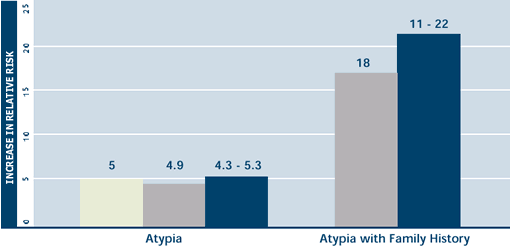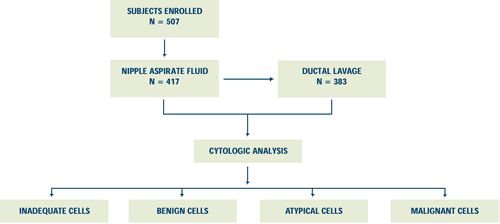|

What is the role of ductal lavage in assessing
breast cancer risk?
 |
|
OVERVIEW:
Studies have concluded that women with atypical breast
ductal epithelial cells have an increased relative risk
of breast cancer. A recent report by Dooley et al compared
ductal lavage to nipple aspiration with regard to safety,
tolerability and the ability to detect abnormal breast
epithelial cells. Ductal lavage was proven to be safe,
well tolerated and superior to nipple aspiration in
collecting large numbers of epithelial cells. Most importantly,
ductal lavage detected abnormal intraductal breast cells
3.2 time more often than nipple aspiration.
Detection of cellular atypia can provide high-risk
patients and their physicians important information
to further assess the patient’s risk and decide
on risk-reduction therapies. Ductal lavage is also an
important tool to be studied in ongoing clinical trials.
In December, 2001, nearly 600 surgeons, many of whom
had previously attended the Miami Breast Cancer Conference
responded to a survey examining how women at high risk
for developing breast cancer are identified and managed.
|
|
 |
 |
| |
|
If you determine
a patient to be high-risk by history and/or quantitative risk
assessment, do you perform ductal lavage on that patient?
Percent of physicians answering
yes.
|
10.2%
|
What factors determine
a patient’s need for ductal lavage in your practice?
|
|
Patients who request it
|
60%
|
|
High-risk patients (by quantitative risk
assessment)
|
53.8%
|
|
Patients with breast cancer (contralateral
breast)
|
39.3%
|
DEFINING THE ROLE OF DUCTAL LAVAGE
There are two things about the study that are important. First,
most of the high-risk women did not have atypical cells. That’s
important information for women who tend to overestimate their risk
and it may not be as high as they believed it to be. Secondly, for
the quarter of the women in whom cellular atypia was detected, we
can be more confident about offering measures to reduce their risk,
such as tamoxifen or surgery. Previously, determining a women’s
risk was based solely on her medical history. Ductal lavage provides
valuable information about the presence or absence of cellular atypia
in the breast without invasive surgery.
Ductal lavage is not a replacement for mammography. It is not
a breast cancer detection tool. It is a risk assessment tool that
can identify women at significant risk for breast cancer. Candidates
for ductal lavage include women with a history who want to monitor
their risk; women who have had one breast cancer and are concerned
about a second; patients who have had breast biopsies that revealed
benign changes but want to see if these changes are evolving; patients
who are considering tamoxifen or chemoprevention to reduce their
risk; and patients who are considering genetic testing or have had
genetic testing and carry an abnormal gene.
The procedure is very easy to perform. It can be done quickly
in an examination room without any special preparation. Patients
tolerate it very well, experience minimal discomfort and report
to us that they would do it again.
—Victor G. Vogel, MD
The identification of cellular atypia by ductal lavage and the
increased relative risk it confers take on further potential importance
in light of the findings of the National Surgical Adjuvant Breast
and Bowel Project P-1 Study...However, how to balance the benefits
and risks of tamoxifen is still a matter of debate, particularly
for women 50 or more years of age. Ductal lavage can provide a woman
with some information about whether she has evidence of cellular
changes associated with increased breast cancer risk at the time
she is weighing the risks and benefits of tamoxifen therapy.
Ductal lavage also offers the potential opportunity to follow
a specific ductal system over time and to identify it should surgical
therapy be indicated. Indeed, in the current clinical trial, the
feasibility of utilizing ductal lavage to detect and direct the
surgical resection of several ductal carcinomas in situ that were
occult on mammography and clinical breast examination has been demonstrated.
To date, 11 subjects with abnormal ductal lavage findings have had
additional imaging and breast surgery to further evaluate their
cytologic findings. Four of the subjects have had a pathologically
confirmed ductal carcinoma in situ located in the same region as
the ductal system with the abnormal ductal lavage findings.
In summary, ductal lavage is a safe and well-tolerated method
of accessing specific milk ducts to collect and detect atypical
and malignant cells within the breast. Ductal lavage is statistically
significantly more sensitive than nipple aspiration for the detection
of cellular atypia. Detection of intraductal cellular abnormalities
can provide women at elevated risk for breast cancer and their physicians
additional information to aid their decision about risk-reduction
therapy and ongoing surveillance.
—Dooley WC et al. J Natl
Cancer Inst 2001;93(21): 1624-32.
Abstract
Ductal lavage is a safe and minimally invasive procedure that
can provide a woman who is at elevated risk for developing breast
carcinoma with additional information regarding that risk. In a
woman with an elevated Gail risk who has no history of biopsy-proven
atypical hyperplasia, a finding of cytologic atypia on ductal lavage
provides risk assessment information that is independent of her
Gail risk. This information can assist the woman and her physician
in weighing the risks and benefits of hormone replacement therapy,
antiestrogen therapy, and, in very high-risk women, prophylactic
mastectomies.
Women must be counseled carefully regarding ductal lavage. Ductal
lavage does not replace mammography, but it can provide additional
insight into risk status. If benign cells are identified by ductal
lavage, a high-risk woman remains at high risk for breast carcinoma.
Long-term outcome studies will determine whether benign cytology
findings on ductal lavage lower a woman’s risk of developing
breast carcinoma, but this has not yet been established. Although
ductal lavage has detected occult tumors in high-risk women, its
sensitivity and specificity for breast cancer detection are not
yet known. This fact must be weighed carefully in any decision-making
process concerning surgical ductal exploration.
The management of the woman at high-risk for the development of
breast carcinoma is an area of increasing clinical importance now
that tamoxifen has shown to be of proven benefit, and because prophylactic
mastectomy clearly decreases breast carcinoma risk in BRCA 1/2 mutation
carriers. Ductal lavage offers additional information regarding
risk to both women and their physicians as they ponder the complex
decisions regarding hormone replacement therapy and antiestrogen
risk-reduction therapy. Ongoing and future clinical studies will
provide more information regarding the positive and negative predictive
values of ductal lavage for breast carcinoma detection; and the
reproducibility, reliability, and clinical utility of ductal lavage
for tracking the progression and regression of intraepithelial neoplasia
with and without the use of antiestrogen therapy.
—O’Shaughnessy JA et
al. Cancer. 2002 Jan
15:94(2):292-298.
Nipple aspirate cytology has several potential uses in research
on breast cancer detection and pre vention. For example results
from our studies of the two groups of women clearly demonstrate
that nipple aspirate cytology is an independent and relatively strong
predictor of breast cancer risk, especially among women who have
had a previous breast biopsy for benign breast disease. Studies
of biochemical and molecular markers in breast duct fluids obtained
by nipple aspiration may discover markers that might be more sensitive
predictors of breast cancer risk than conventional cytology. More
over, nipple aspirate cytology provides a more complete picture
of the natural history of proliferative changes in the breasts of
women in the general population who do not have apparent breast
disease than breast biopsy, which is performed only in response
to abnormalities found at physical examination or detected by mammography.
Studies that combine the results of nipple aspiration cytology with
observations of areas of high radiographic density in mammograms
may further facilitate the detection of disease in women at high
risk for breast cancer. Finally, nipple aspirate cytology and duct
fluid analysis may find use by providing i n t e rmediate endpoints
in studies of breast cancer pathogenesis and in clinical trials
of new chemopreventive agents against breast cancer and benign breast
disease. We strongly support the efforts of clinical investigators
to find applications for this easy-to-perform , noninvasive procedure
.
—Wrensch MR et al. J Natl
Cancer Inst 2001;93(23): 1791-8.
Abstract
BREAST CANCER RISK IN WOMEN WITH ABNORMAL CYTOLOGY
IN NIPPLE ASPIRATES OF BREAST FLUID NO PROTOCOL LINK
REMARKABLY SIMILAR INCREASES IN RELATIVE RISK CONFERRED
BY CYTOLOGY AND PATHOLOGY

|
|
FNA Cytology
— Fabian,
et al
|
|
NAF Cytology
— Wrensch,
et al. |
|
Pathology Studies
— Dupont and Page
— Dupont et al |
Wrensch et al studied 2300 women for an average of 12.7 years to
determine the relationship between atypical findings on analysis
of nipple aspirate fluid (NAF) and the development of breast cancer.
The results of their study showed a 4.9-fold increase for the subsequent
development of breast cancer in women with the finding of cellular
atypia in NAF specimens without a family history. For patients with
cellular atypia and a family history of breast cancer, the relative
risk was raised to 18-fold. FNA cytology studies and pathology studies
have shown similar increases in relative risk.
Wrensch MR et al. J Natl Cancer Inst 2001;93(23):1791-8. Abstract
Dupont WD, Page DL. N Engl J Med 1985;312(3):146-51. Abstract
Dupont WD et al. Cancer 1993;71(4):1258-65. Abstract
Fabian C et al. J Natl Cancer Inst 2000;92:1217-27. Abstract
DUCTAL LAVAGE: THE PROCEDURE
|
1. Gentle suction is applied to the
nipple to elicit fluid.
|
|
|
3. 10-20 mL of saline is slowly introduced into
the milk duct in 2 – 4 mL increments to
lavage the duct and collect epithelial cells. |
|
2. Microcatheter is
inserted into duct.
|
|
|
4.The breast is massaged to bring fluid forward. |
 |
DUCTAL LAVAGE FOR THE DETECTION OF CELLULAR
ATYPIA IN WOMEN AT HIGH RISK
FOR BREAST CANCER CLOSED PROTOCOL |
|
Eligibility: High-risk
women (Gail Index >=1.7, personal history of breast cancer,
DCIS, LCIS or BRCA1/BRCA2 positive) with a normal mammogram
and clinical breast exam within the past 12 months. Women
with prior irradiation or significant surgery on the breast
to be lavaged, current chemotherapy or tamoxifen/SERM therapy
were ineligible.

|
| |
|
Dooley et al compared ductal lavage to nipple aspiration
with regard to safety, tolerability and the ability to detect
abnormal breast epithelial cells. 507 women were enrolled
and nipple aspiration and ductal lavage were attempted for
NAF yielding ducts. Cytologic analysis was performed on satisfactory
specimens.
Dooley WC et al. J Natl Cancer Inst 2001;93(21):1624-32.
Abstract
|
 |
| |
|
STUDY RESULTS: SPECIMEN ADEQUACY
FOR DIAGNOSIS
|
|
NAF
|
27%
|
|
Ductal lavage
|
78%
|
|
|
STUDY RESULTS: ABILITY TO DETECT ABNORMAL CELLS
|
Mildly
Atypical
|
|
NAF
|
6%
|
|
Ductal lavage
|
17%
|
|
Markedly
Atypical
|
|
NAF
|
3%
|
|
Ductal lavage
|
6%
|
|
Malignant
|
|
NAF
|
< 1%
|
|
Ductal lavage
|
< 1%
|
Dooley WC et al. J Natl Cancer Inst. 2001;93(21):1624-32.
Abstract
|
 |
| DUCTAL LAVAGE AND CLINICAL MANAGEMENT
PATHWAY |
|
|
|
| |
|
Reproduced with permission: O’Shaughnessy et al. Cancer
2002; 94 (2)
|
 |
| |
View References
Back | Top of Page

|



